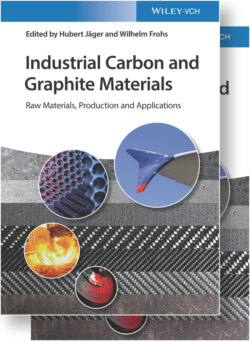Читать книгу Industrial Carbon and Graphite Materials - Группа авторов - Страница 279
6.1.2.3.1.2 Fluid Coking
ОглавлениеThe continuous fluid coking process utilizes fluidized solids technique developed for fluid catalytic cracking, except that no catalyst is used. A flow scheme is shown in Figure 6.1.2.6.
Residue is feed to the reactor (a). The cracking reactions occur at 500–550 °C in a fluidized bed of coke particles. The coke formed in the reactor flows continuously to the heater, where it is heated up to 600–650 °C by partial combustion in a second fluidized bed. Some parts of the heated coke particles are returned to the reactor in order to supply the energy for the endothermic crack reactions and to maintain the reactor temperature. The remainder of the coke after cooling is removed as a stream of fine particle “petroleum coke.” Fluid coke is only occasionally used for production of anodes [24].
Table 6.1.2.3 Time allotted for different steps in typical 12 and 24 hours coking cycles.
| Operation step | Time (h) | |
|---|---|---|
| Coking cycle | 24‐hour cycle | 12‐hour cycle |
| Switch drum | 0.5 | a) |
| Steam out to fractionator | 0.5 | a) |
| Steam out to blowdown | 1.0 | |
| Slow water cooling | 1.0 | b) |
| Full water rate | 5.0 | b |
| Drain water and remove top head | 3.5 | 1.5 |
| Drop bottom head and feed line | 0.5 | 0.5 |
| Hydraulic decoking | 4.0 | 2.0 |
| Replace heads and feed line | 1.0 | 0.5 |
| Steam purge and pressure test | 1.0 | 0.75 |
| Drum heat up | 4.0 | 2.25 |
| Slippage allowance | 2.0 | 1.0 |
| Total | 24 hours | 12 hours |
a) Total time for both operation steps: 0.5.
b) Total time for both operation steps: 3.0.
Figure 6.1.2.6 Flow sheet of fluid coking. (a) Reactor. (b) Scrubber. (c) Burner. (d) Air blower.
